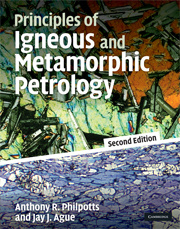Book contents
- Frontmatter
- Contents
- Preface
- Acknowledgments
- List of units
- 1 Introduction
- 2 Physical properties of magma
- 3 Intrusion of magma
- 4 Forms of igneous bodies
- 5 Cooling of igneous bodies and other diffusion processes
- 6 Classification of igneous rocks
- 7 Introduction to thermodynamics
- 8 Free energy and phase equilibria
- 9 Thermodynamics of solutions
- 10 Phase equilibria in igneous systems
- 11 Effects of volatiles on melt equilibria
- 12 Crystal growth
- 13 Isotope geochemistry related to petrology
- 14 Magmatic processes
- 15 Igneous rock associations
- 16 Metamorphism and metamorphic facies
- 17 Deformation and textures of metamorphic rocks
- 18 Graphical analysis of metamorphic mineral assemblages
- 19 Geothermometry, geobarometry, and mineral reactions among solid solutions
- 20 Mineral reactions involving H2O and CO2
- 21 Material transport during metamorphism
- 22 Pressure–temperature–time paths and heat transfer during metamorphism
- 23 Origin of rocks
- Answers to selected numerical problems
- References
- Index
4 - Forms of igneous bodies
- Frontmatter
- Contents
- Preface
- Acknowledgments
- List of units
- 1 Introduction
- 2 Physical properties of magma
- 3 Intrusion of magma
- 4 Forms of igneous bodies
- 5 Cooling of igneous bodies and other diffusion processes
- 6 Classification of igneous rocks
- 7 Introduction to thermodynamics
- 8 Free energy and phase equilibria
- 9 Thermodynamics of solutions
- 10 Phase equilibria in igneous systems
- 11 Effects of volatiles on melt equilibria
- 12 Crystal growth
- 13 Isotope geochemistry related to petrology
- 14 Magmatic processes
- 15 Igneous rock associations
- 16 Metamorphism and metamorphic facies
- 17 Deformation and textures of metamorphic rocks
- 18 Graphical analysis of metamorphic mineral assemblages
- 19 Geothermometry, geobarometry, and mineral reactions among solid solutions
- 20 Mineral reactions involving H2O and CO2
- 21 Material transport during metamorphism
- 22 Pressure–temperature–time paths and heat transfer during metamorphism
- 23 Origin of rocks
- Answers to selected numerical problems
- References
- Index
Summary
INTRODUCTION
Bodies of igneous rock are referred to as extrusive when formed on the Earth's surface, and intrusive when formed within the Earth. Intrusive bodies are further subdivided into plutonic – large intrusions formed at moderate to great depth, and hypabyssal – small intrusions formed near the Earth's surface. Hypabyssal rocks cool rapidly, and most resemble volcanic rocks more than plutonic ones. Extrusive bodies of igneous rock are relatively well understood, for many of them have actually been studied during their formation. The same cannot be said for plutonic bodies, where even their form may be uncertain and their formative processes often conjectural. We, therefore, start with a discussion of extrusive bodies.
Extrusive bodies
When thinking of volcanic forms, it is natural to picture a volcano such as Mount Fuji. Although such spectacular edifices are common, the largest volumes of volcanic rock in the geological record erupted to form less striking features. By far the most voluminous volcanic rocks on Earth are the basaltic flows covering the ocean floor. Most of these were erupted from fissures along mid-ocean ridges where they poured out to fill the axial valleys. Fissure eruptions of basalt also constitute the most voluminous rocks on continents. Coming in a close second with regard to volume are huge sheets of rhyolitic volcanic ash. Nine percent of the world's population lives within 100 km of an active volcano, and although many large eruptions in historic times have had disastrous effects on humans (de Boer and Sanders,2004), no eruption has been on the scale of the large ones found in the geologic record.
- Type
- Chapter
- Information
- Principles of Igneous and Metamorphic Petrology , pp. 52 - 110Publisher: Cambridge University PressPrint publication year: 2009



